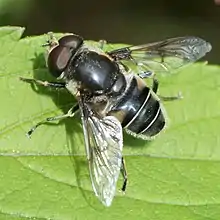Eristalis saxorum
'Eristalis saxorum ( Wiedemann, 1830 ), the Blue-polished Drone Fly , is an uncommon species of syrphid fly found along the Eastern United States. Hoverflies get their names from the ability to remain nearly motionless while in flight. The adults are also known as flower flies for they are commonly found around and on flowers, from which they get both energy-giving nectar and protein-rich pollen. The larvae are aquatic filter-feeders of the rat-tailed type. The larvae of this species have not been identified.[1][2][3][4] Little is known about this uncommon species which flies from mid-March to late October.[4][1][2][3]
| Eristalis saxorum | |
|---|---|
 | |
| Scientific classification | |
| Domain: | Eukaryota |
| Kingdom: | Animalia |
| Phylum: | Arthropoda |
| Class: | Insecta |
| Order: | Diptera |
| Family: | Syrphidae |
| Genus: | Eristalis |
| Species: | E. saxorum |
| Binomial name | |
| Eristalis saxorum Wiedemann, 1830 | |
References
- "Eristalis saxorum Report". Integrated Taxonomic Information System. Retrieved 2019-09-25.
- "Eristalis saxorum". GBIF. Retrieved 2019-09-25.
- "Eristalis saxorum species Information". BugGuide.net. Retrieved 2019-09-25.
- Skevington, Jeffrey H.; Locke, Michelle M.; Young, Andrew D.; Moran, Kevin; Crins, William J.; Marshall, Stephen A. (2019). Field Guide to the Flower Flies of Northeastern North America. Princeton, New Jersey: Princeton University Press. ISBN 9780691189406.
Further reading
- Telford, H. S. (1970). "Eristalis (Diptera: Syrphidae) from America North of Mexico". Annals of the Entomological Society of America. 63 (5): 1201–1210. doi:10.1093/aesa/63.5.1201.
This article is issued from Wikipedia. The text is licensed under Creative Commons - Attribution - Sharealike. Additional terms may apply for the media files.